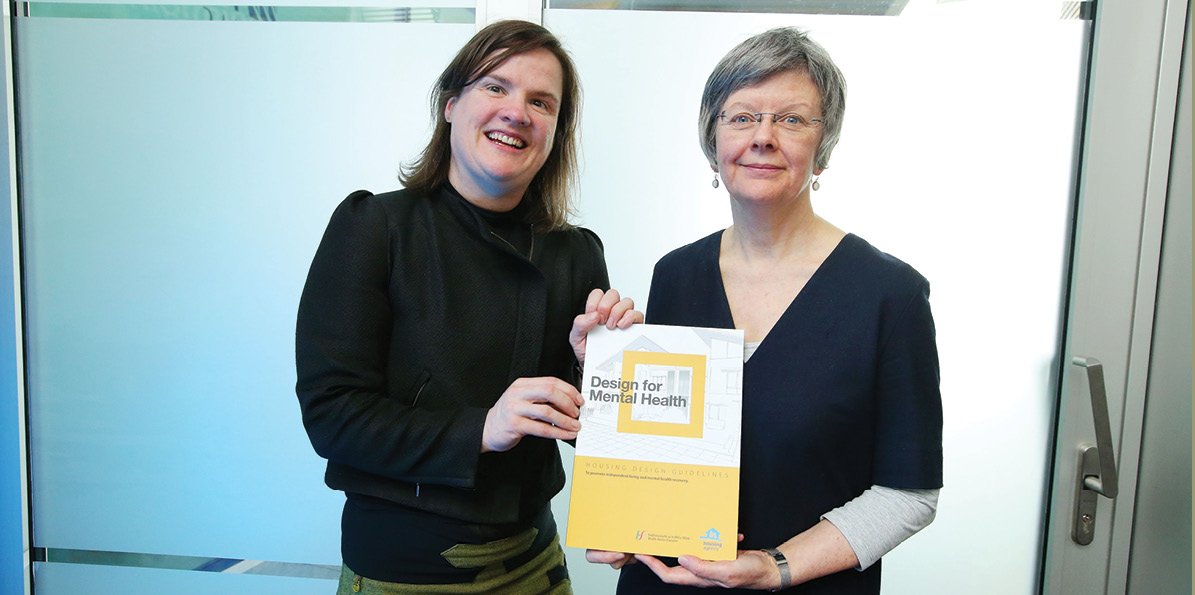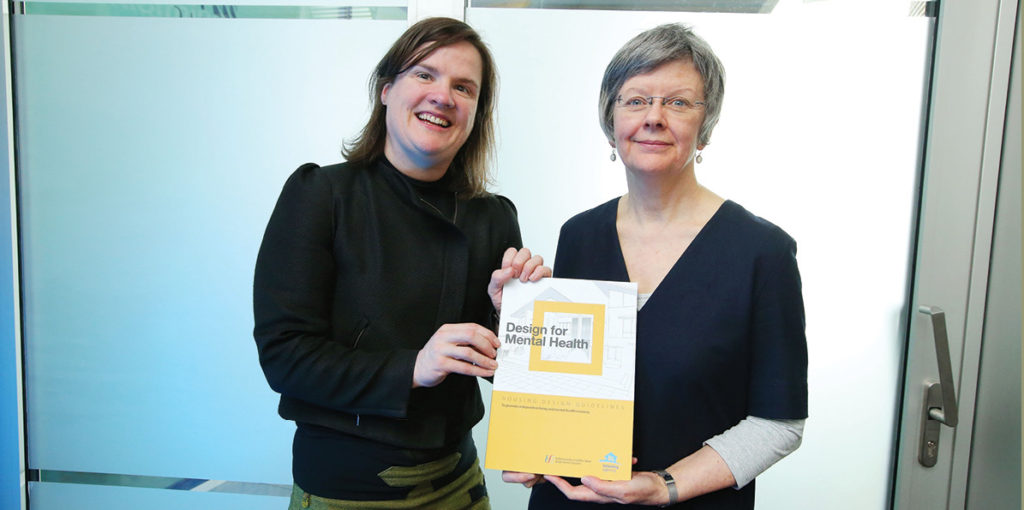Designing for mental health


Isoilde Dillion, an architect with the Housing Agency, and Áine O’Reilly, an occupational therapist with the Health Service Executive presented the Design for Mental Health plan at the Northern Ireland Housing Conference. eolas reports.
It is estimated that one in four people will experience mental health problems at some point during their lives. Mental illness is a broad concept that encompasses a series of conditions including anxiety disorder, depression, hypomania, bipolar disorder, psychosis and schizophrenia. The impact upon independent living are interwoven with the impacts of treatment and the characteristics of an individual’s immediate physical and social environment. For instance, many of those who suffer from mental health issues experience lower rates of employment, do not socialise regularly, simultaneously possess physical disorders and are subject to both social stigma and violent crime.
The Design for Mental Health document is a product of cooperation between the Health Service Executive (HSE) and the Housing Agency and establishes the guidelines for the promotion of independent living and mental health recovery. The guidance has a wide target audience ranging from architects and design professionals to local authorities and housing bodies, and service users to health service professionals.
Rationale
Contextualising the emergence of the plan, Áine O’Reilly outlines that following the HSE liquidation of a portion of its property assets, a series of infrastructure projects were undertaken with the recouped capital. While she acknowledges that most of these were successful, O’Reilly expressed reservation concerning an old plan for high support hostels with 18 beds. Emphasising her perspective as an occupational therapist, she believes that some of the features of institutions inevitably work against the people who live in them in terms of their skills and abilities.
O’Reilly notes: “Our management team asked me to suggest an alternative. So, I found a wealth of material on housing models and choice, strategies for housing people with disabilities, the impact of the built environment on public mental health in general and a huge body of literature on the range of disabilities experienced by those with severe and enduring mental health problems.
“There is also a significant volume of literature on the design of psychiatric hospitals and long-term facilities, inclusive architecture, as well as design guidance for specific groups. However, there was nothing on design guidance to bypass or overcome the specific difficulties experienced by those diagnosed with mental health conditions.”
Thus, the origin of the guidelines lay with the objective of identifying alternative designs for homes which could facilitate the deconstruction of barriers to independent living for those diagnosed with mental health conditions. This rationale is in line with the Irish Government’s overarching strategy on mental health which, at its core, is committed to community care and recovery. However, in wake of the closure of psychiatric institutions there is an increased urgency to provide suitable homes for those with mental health disorders.
O’Reilly elaborates: “We put together terms of reference outlining the existing literature, the guidance gap in mental health and what we wanted to achieve. The terms of reference concerned the identification of difficulties in independent living experienced by people with severe and enduring mental health problems and the environmental influences on mental wellbeing. We also wanted to investigate how design can support people to compensate for their disability, to maximise their independence and to integrate into their community. Furthermore, we aimed to develop a guideline containing practical design and technology solutions.
“We sent this out to a variety of groups including the housing associations and health professionals. There were a lot of people interested in this area. Having put together such a group of people with such expertise, we suddenly had to complete this project.
An initial task listed in the terms of reference was the identification of the difficulties concerning independent living. Having read the literature alongside the health professionals, there were three broad sets of difficulties that we came across.”
Cognitive difficulties are the feature that most defines the degree to which a person with mental health difficulties will experience disability. The more prominent this set of difficulties is, the more intense the disability that the person is likely to experience. Physical difficulties include lifestyle choices or medication side effects such as weight gain and tremors. The social difficulties are a whole separate set of problems. They range from things like income to social stigma. The considerations are myriad.
“Technology is going to make a huge difference to independent living.”
“All of these things were considered and blended into the mix when constructing our document. Examples of the kind of recommendations that can be found in the guidelines include design solutions for gardens belonging to people with cognitive difficulties. None of it is rocket science, but it is a combination of small and inexpensive measures which blend together to make a significant difference,” O’Reilly asserts.
“Some design solutions can alleviate poor self-care. An exceptionally well organised environment, which incorporates things like labels, prompt signals and anticipates other design consequences can ensure substantial benefits for a service user with cognitive difficulties. Again, it doesn’t sound like rocket science, but what we’ve tried to achieve is a thoroughness through our document,” she explains.
What resulted was a handbook which, through the design of homes, can make it as easy as possible for a person with a severe and enduring mental health difficulty to live independently. It places emphasis on seemingly minor things which can make a huge difference.
The document
Isoilde Dillon provides an overview of the 120-page document itself. “It is aimed primarily at the service users themselves, people with mental health difficulties and their families. The wider audience also includes housing practitioners, occupational therapists, other healthcare professionals and architects. There are four sections within the document including an overview section, one on the home, one on spaces within the home and a final one on detailed design.”
The document stems from a series of principles, connected to associated considerations and subsequent recommendations. An example provided by Dillon concerns the principle of optimal levels of artificial lighting. “Some of the considerations may concern the fact that a high proportion of service users may have visual acuity problems, or may not respond appropriately to changes in lighting. The recommendations would then be built around that. In this instance, they could include dedicated task lighting, using seasonal affective disorder boxes or even having automatic controls on blinds. This can make the difference to ensure that someone lives comfortably in their home.”
Assistive technology
Assistive technology, such as telecare, can provide remote monitoring and rapid response to enable independent living for those diagnosed with mental health disorders. The technology can identify the occurrence of adverse events through sensors linked to monitoring centres. This has the dual advantage of providing reassurance for both service users and their families. Specifically relating to mental health, such technology can circumvent relapse through early detection of behavioural shifts. However, effectiveness relies upon the perceived usefulness of the product, its ease of assimilation into daily living and, crucially, the challenges posed to privacy and independence as an objective. As such, the Design for Mental Health recommends that service users be consulted during the design process to ensure that an assistive technology package is both suitable and beneficial.
O’Reilly maintains: “Technology is going to make a huge difference to independent living and it’s a really exciting area of Design for Mental Health. It provides carer reassurance, because one of the major difficulties is that people are worried that if someone is on their own that something awful could happen to them. If we think through all the possible scenarios and design around them, it can help.
“Hopefully more and more people with very complex needs can be supported to live within their own, independent environment. What happens when people get into institutions is that a vicious cycle initiates and a person becomes less able to live independently, whereas if you place people in their own homes, with reduced environmental stressors, a more benign cycle takes place. I know that’s quite idealistic, but it does happen. We see people who were living in institutions for years, getting their own homes and subsequently blossoming within their local communities.”





